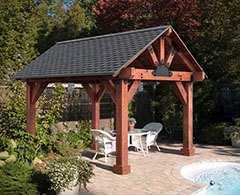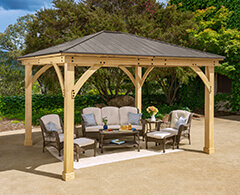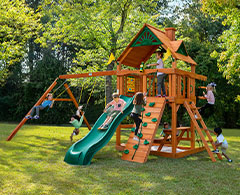Before your dream shed takes shape, a solid shed foundation is crucial to ensure longevity. Here are a few tips to make the process simple.
Why shed foundations are important
Before we get started, let us explain why building a foundation is important. It might seem easier to place a shed directly on the ground, but that’s a bad idea for two reasons. First, the build site should be a level surface so the shed is stable and the doors function properly. Secondly, any wood that has direct contact with the ground will absorb moisture and cause premature rot and decay. A shed should be raised slightly so there is proper water drainage and ventilation underneath. Building a shed foundation might seem like more work, but it’s well worth it.
Determine if you need a building permit for your shed
Before you choose a location to install your shed, consult your local Home Owners Association (HOA) or Building Department to see if you will need a permit and what guidelines there might be. Every county has different guidelines, so we strongly suggest to not skip this step. Confirm the following with your HOA/Building Department:
- Shed type and size
- Frost line
- Location
- Foundation Type
- Required building permits
Do you need a foundation for your shed?
Typically, small sheds in the size range of 6×8 or smaller do not require a foundation. However, we suggest placing all sheds on a foundation for structure and ventilation purposes.
Where should you build your shed foundation?
Choose a spot that is within 6” level* and does not collect large amounts of water. Make sure there is 3’of clearance from other objects such as trees and other buildings.** For 10×16 sheds or larger, give yourself 4’ of clearance so there is adequate space to move.
Heartland Sheds Foundation Requirements: *Prior to the arrival of the installer, your build site must be level within 6”. Additional charges may apply if this requirement is not met. We require 3ft. of clearance on all sides for installations and 4’ for buildings 160 square feet or larger.
Frost Line:
Frost line is known as the depth at which water in soil is expected to freeze. In areas with colder climates, structures may move due to seasonal freeze and thaw changes and that makes your frost line crucial. In general, frost lines get deeper the closer you get to the poles. Be sure to contact your HOA to determine the frost line for your area. Or view this frost line map to see the frost line for your state.
Tools needed:
|
Chalk Reels |
Concrete Leveling |
Tape Measure |
|---|---|---|
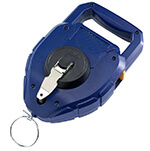 |
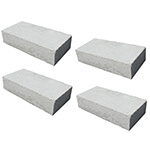 |
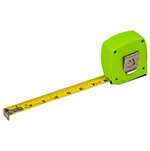 |
|
Hammer |
Level |
|
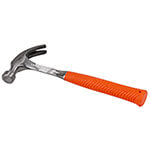 |
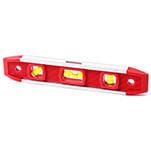 |
Shed Foundation Types:
Sheds can be built on the following type of foundations:
- Concrete floor
- Concrete piers
- Compacted gravel
- Wood foundations
We are going to focus on wood and concrete foundations in this article as that is our preferred type.
Wood Shed Foundations
Wood shed foundations are typically built using solid concrete blocks measuring 16”W x 8”L x 2”H, pea gravel, 4×4 pressure-treated lumber and a wooden floor frame. Concrete leveling blocks can be purchased separately with any Heartland order.
- Begin by laying out your floor size and locating pea gravel and concrete blocks. Play each block 12” from each corner of the floor frame.
- Place the concrete blocks on pea gravel.
- Use the pea gravel to level your foundation. Blocks along the same floor joist should be a maximum of 72” apart. The spacing between blocks on different floor joists should be a maximum of 48” apart (See floor layout below).
- Once all blocks are located, place the 4×4’s onto the blocks and continue by building your floor frame and securing the frame to the 4×4’s. The 4×4’s allow proper ventilation underneath your shed. Once the floor frame is built, you can easily level your shed using more or less pea gravel at various locations.
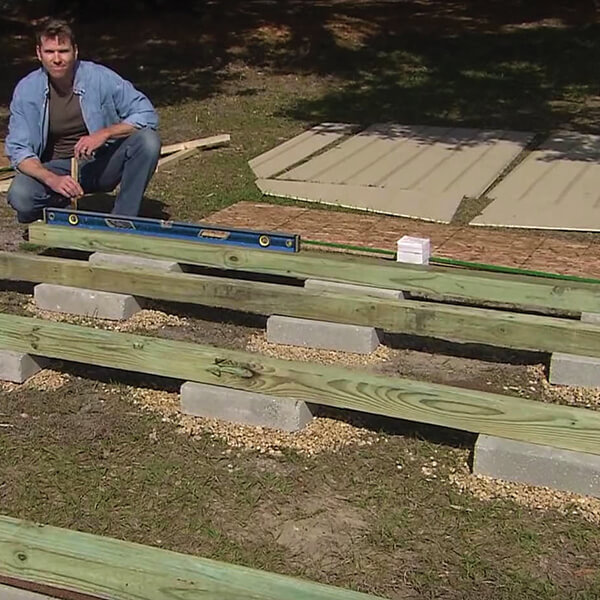
Estimated number of concrete blocks based on shed size (more will be required for any surface that is unlevel):
| Shed Size | Number of Blocks | Shed Size | Number of Blocks |
|---|---|---|---|
| 6X6 | 8 | 12x12 | 16 |
| 8X8 | 8 | 12x16 | 22 |
| 8X6 | 8 | 12x20 | 26 |
| 8X10 | 10 | 12x24 | 30 |
| 8X12 | 12 | 16x20 | 50 — *Piers or foundation may be required by state |
| 10X10 | 14 | 16x24 | 55 — *Piers or foundation may be required by state |
| 10X12 | 16 | ||
| 10x16 | 20 |

Click on image to see enlarged.
Concrete Shed Foundations
We also recommend our customers to use a concrete slab for their shed foundations.
Heartland does not employ, endorse or in any way recommend any qualified concrete specialists for sheds. It is the responsibility of the homeowner to assure compliance to these specs.

Concrete Foundation Guidelines:
- The build site must be level and should have natural drainage and no standing water. This will keep excess moisture away from the foundation and extend your sheds’ life.
- Your concrete slab should be minimally the same width and depth as the shed. We use MCA or ACQ treated plates around the entire perimeter of the walls. Customers can choose to leave the bottom plate attached behind the door or have it cut out.
- The slab can be no greater than 1/2” out of “square” and no more than a 1/4’’ out of “level.” Any variation to this will cause delays or even stop the installation process. 1/4” out of level at the floor can lead to more than 1” out of level at the roof depending on building size and roof style.
- Based on “local code requirements” wedge style anchor bolts should be set in the concrete around the entire perimeter (12” from corners and 4’ on center thereafter) of the slab (except where the door goes) projecting approx. 2 ½” above the slab grade and approx. 1-3/4” to 2” from the edge of the slab. Minimum anchor embedment should be 2-1/2”-3” into the concrete. We recommend ½ diameter x 8-1/2 long Simpson Wedge.
- Your finished concrete slab surface needs to be at a minimum of 4″ above grade.
REMEMBER: You should ensure that your region allows this type of foundation as well as conformance to all applicable zoning and/or building codes.
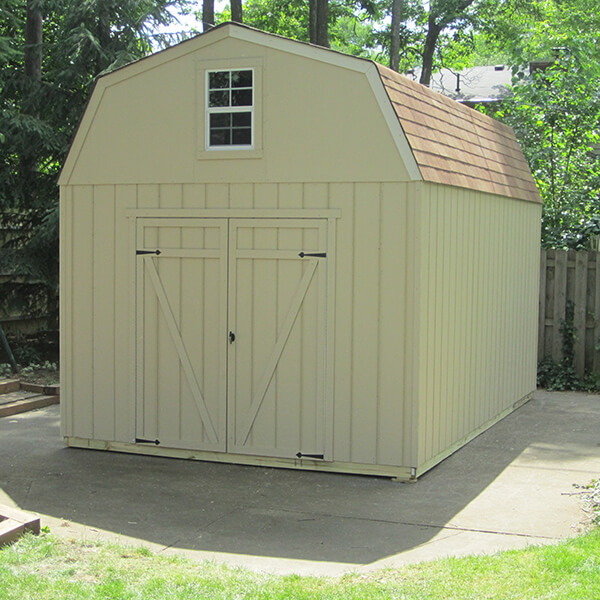
Best Shed Foundations
These are our preferred types of shed foundations. See how they compare.
| WOOD FOUNDATIONS | CONCRETE FOUNDATIONS | ||
|---|---|---|---|
| Advantages | Disadvantages | Advantages | Disadvantages |
| Most economical | Can sink slightly over time | Can place wood frame directly on concrete slab | Soil can cause settlement over time |
| Easy to move concrete blocks to desired location | Not suitable for slopes greater than 24” | Full support of shed frame | More costly |
| Great for most sheds | Not suitable to store cars or boats | Can secure shed/walls to concrete floor | May require professional help that further increases costs |
| Does not require much excavating | Can store cars or boats | ||
Purchasing a shed can be a big investment. However, preparing your foundation properly will help ensure your shed is ready to handle the elements 365 days a year. If you have any questions, feel free to give us a call at 800-234-6167.
HELPFUL RESOURCES:
How to Build a Storage Shed
How to Shingle a Shed
Other Links:
Shed Buyer’s Guide
FAQ’S
